
- Subject:
- Applied Science
- Biology
- Life Science
- Material Type:
- Module
- Date Added:
- 07/10/2017

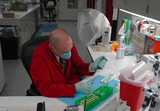
By the end of this section, you will be able to:Identify and describe the properties of lifeDescribe the levels of organization among living thingsRecognize and interpret a phylogenetic treeList examples of different sub disciplines in biology

By the end of this section, you will be able to:Identify and describe the properties of lifeDescribe the levels of organization among living thingsRecognize and interpret a phylogenetic treeList examples of different sub disciplines in biology
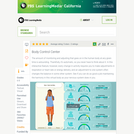
Throughout the day, your nervous system monitors and makes endless adjustments to your body's basic systems -- all to keep you alive. This interactive feature illustrates the complexity of such a task.

This resource is a video abstract of a research paper created by Research Square on behalf of its authors. It provides a synopsis that's easy to understand, and can be used to introduce the topics it covers to students, researchers, and the general public. The video's transcript is also provided in full, with a portion provided below for preview:
"Thrombospondin-1, or TSP-1, is a calcium-binding protein implicated in the development of several diseases, including diabetes, cancer, renal failure, and cardiovascular disease. To understand TSP-1’s role in disease, researchers recently examined the protein’s effects on the calcium dynamics, survival, and deformability of red blood cells. In vitro experiments showed that exposure to recombinant human TSP-1 significantly increased calcium levels in red blood cells. TSP-1 treatment also induced an inward ionic current, suggesting possible calcium influx through non-selective cation channels, and TSP-1 caused the deformation of red blood cells. Further experiments revealed that TSP-1 binding to its receptor CD47 could dictate the lifespan of red blood cells in circulation. Altogether, the findings suggest that TSP-1/CD47 signaling could be one targetable pathway in systemic diseases that attack red blood cells..."
The rest of the transcript, along with a link to the research itself, is available on the resource itself.

Immune cells protect our bodies from both self-derived threats and exogenous pathogens, while keeping peace with normal cells and non-harmful commensal microbiota. They have various mechanisms to perform these tasks, a capacity that is essential for maintaining homeostasis. However, these same mechanisms can backfire, resulting in severe disorders such as immunodeficiency, chronic inflammation, allergy, degenerative diseases, and cancer. This course discusses the connections between normal physiology and disease by examining the developmental relationship between innate and adaptive immune cells as well as the functions and malfunctions of immune cells. The course familiarizes students with both basic biological principles (such as cell death and immune cell signaling) and clinical applications (such as immune checkpoint blockade). More generally, students learn to identify relevant primary research literature, critically evaluate experimental data, and reach their own conclusions based on primary data.
This course is one of many Advanced Undergraduate Seminars offered by the Biology Department at MIT. These seminars are tailored for students with an interest in using primary research literature to discuss and learn about current biological research in a highly interactive setting. Many instructors of the Advanced Undergraduate Seminars are postdoctoral scientists with a strong interest in teaching.

This video describes the role of the brain in regulating body temperature and how sometimes fever is employed to fight off infection.
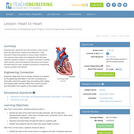
Students learn about the form and function of the human heart through lecture, research and dissection. They brainstorm ideas that pertain to various heart conditions and organize these ideas into categories that help them research possible solutions. An expert in the field of cardiac valve research was interviewed for this lesson and shares his ideas with the class. Students conclude by researching various possible heart defects.

Ever wondered why your temperature stays at 98.6 degrees? Learn about homeostasis and how your body maintains a stable temperature. Created by MIT+K12.

This resource provides a short reading section with experimental data and a few questions about the text. It was created with standardized assessment in mind and aligned with Next Generation Science Standards.

The overall purpose of this preparatory course textbook is to help students familiarize with some terms and some basic concepts they will find later in the Human Anatomy and Physiology I course.
The organization and functioning of the human organism generally is discussed in terms of different levels of increasing complexity, from the smallest building blocks to the entire body. This Anatomy and Physiology preparatory course covers the foundations on the chemical level, and a basic introduction to cellular level, organ level, and organ system levels. There is also an introduction to homeostasis at the beginning.
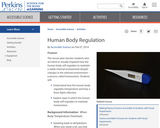
This activity was designed for blind learners, but all types of learners can use it to learn how the body self-regulates. This lesson plan teaches students how the human body self-regulates to maintain a stable internal environment despite changes in the external environment -- a process called homeostasis. Most of the activities detailed in this lesson plan can be done with visually impaired students if teachers adapt them using Resources for Teaching and Adapting Lessons for Students with Visual Impairments.
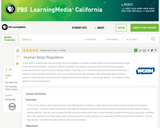
Students learn how the human body self-regulates to maintain a stable internal environment despite changes in the external environment.

This resource is a video abstract of a research paper created by Research Square on behalf of its authors. It provides a synopsis that's easy to understand, and can be used to introduce the topics it covers to students, researchers, and the general public. The video's transcript is also provided in full, with a portion provided below for preview:
"Inflammatory bowel diseases (IBDs), such as Crohn’s disease and ulcerative colitis, affect more than 0.3% of the Western population. The sheer complexity of these diseases presents a major challenge to treatment, as it has created a disconnect between microbiologists studying the effects of the microbiome, immunologists studying immune responses, and clinicians who treat individuals with IBD. To mount a more holistic approach, researchers recently examined the crosstalk between immune cells and bacteria in the colon. Experiments revealed the significance of bacterial products called outer membrane vesicles, or OMVs. OMVs are tiny sacs of cellular material released by bacteria as a way of communicating with immune cells. In patients with Crohn’s disease or ulcerative colitis, OMVs elicited only a small fraction of their normal immune response, suggesting a breakdown in immune–microbiota communication..."
The rest of the transcript, along with a link to the research itself, is available on the resource itself.
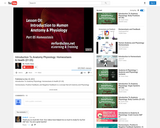
Homeostasis, Positive Feedback and Negative Feedback are key to any study of the human body. We take a look at this important topic. We also define the term health.
This is lesson 5 in the Free Introduction to Human Anatomy and Physiology lessons found at mrfordsclass.net. In these lessons you will find lecture notes from my class and exam reviews. Check it out.
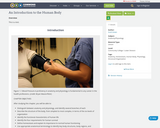
This is a test.
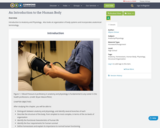
Introduction to Anatomy and Physiology. Also looks at organization of body systems and incorporates anatomical terminology.

Using ordinary household materials, student “biomedical engineering” teams design prototype models that demonstrate semipermeability under the hypothetical scenario that they are creating a teaching tool for medical students. Working within material constraints, each model consists of two layers of a medium separated by material acting as the membrane. The competing groups must each demonstrate how water (or another substance) passes through the first layer of the medium, through the membrane, and into the second layer of the medium. After a few test/evaluate/redesign cycles, teams present their best prototypes to the rest of the class. Then student teams collaborate as a class to create one optimal design that reflects what they learned from the group design successes and failures. A pre/post-quiz, worksheet and rubric are provided.

Students learn about the form and function of the human heart through the dissection of sheep hearts. They learn about the different parts of the heart and are able to identify the anatomical structures and compare them to the all of the structural components of the human heart they learned about in the associated lesson, Heart to Heart.

There are countless types of plants and animals on Earth, but how do they work? In this episode of Crash Course Biology, we’ll take a bird’s eye view of how multicellular life functions, including how it’s organized, how it regulates itself to maintain homeostasis, and the big question: Why are these living things so wildly complex?
Chapters:
Introduction: Bizarre Beasts
Multicellular Organization
Cell Specialization
Why We Aren't Unicellular
Cons of Multicellularity
Dr. Rebeca Gerschman
Homeostasis
Review & Credits
Credits